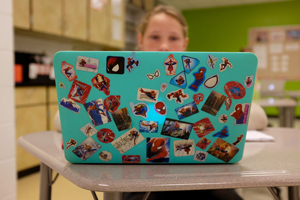 The intersections between learning, technology, and media are often scenes of tumult and change. These digital texts and tools provide groundbreaking opportunities to communicate and access information that cannot be underestimated. Sadly, however, they also enable people to spread hate, vitriolic language, and bigotry—harmful discourses that are often embedded with elements of harassment, threat, cyberbullying, and trolling. Today’s educators struggle with how to discuss these trends that affect youth learning and engagement in myriad, global contexts.
The intersections between learning, technology, and media are often scenes of tumult and change. These digital texts and tools provide groundbreaking opportunities to communicate and access information that cannot be underestimated. Sadly, however, they also enable people to spread hate, vitriolic language, and bigotry—harmful discourses that are often embedded with elements of harassment, threat, cyberbullying, and trolling. Today’s educators struggle with how to discuss these trends that affect youth learning and engagement in myriad, global contexts.
In the context of recent events, we need to be cognizant that children and young adults (and their educators) are watching and learning from these interactions. Children may be exposed to harmful discourses or hate speech as they read or communicate online. In an Edutopia article, author Jinnie Spiegler defines online hate speech as “the use of electronic communications technology to spread bigoted or hateful messages or information about people based on their actual (or perceived) race, ethnicity, national origin, religion, gender, sexual orientation, disability, or similar characteristic.” After encountering these messages, students may bring them into our buildings and disseminate them.
What to do
There are several ways educators can address harmful discourse if it enters the classroom. The first step is to observe the culture of your classroom and school campus. It’s also important to keep in mind the age and developmental level of students before working to address challenging content. You’ll want to make sure that your response is appropriate, direct, and devoid of your own bias, perspective, or judgement.
In The Educator's Playbook, professor Howard C. Stevenson suggests four steps that educators can take to confront hate speech at school:
- Start with you: Process your own feelings, and address your own vulnerabilities before entering the classroom. Develop a support system with your colleagues. Review school and district policies as they relate to these issues.
- Practice: Classroom reactions usually happen in a split second. Prepare yourself for these instances by role-playing with colleagues in your building, or online with your professional learning network.
- After an incident: Resist the urge to condemn the action or content. First try to understand the motivation if is disseminated through your classroom or building. Allow the school’s code of conduct to address instances where students actively spread this information. Strongly explain to students that these harmful discourses and the messages being spread about individuals and groups are not accepted. You will not accept the silencing of voices.
- Keep talking: After these events, the best course of action is to keep talking. Difficult discussions will often ensue, but children and adults alike need to be able to process their feelings and reactions. This is an opportunity to shut down and be silent, or engage and promote change.
Proactive curriculum
There is also a wealth of resources available online to help address these harmful discourses before they enter your classroom or school campus. Teaching Tolerance offers a guide for administrators, counselors, and teachers on “Responding to Hate and Bias at School” as well as how to “Speak Up at School” about prejudice, bias, and stereotypes. Edutopia also provides a collection of resources to help you learn more about Internet safety, cyberbullying, and media literacy.
Counteract harmful discourses
It is imperative that we explore how information and technology shapes the contours of the spaces in which learning takes place. Within these contexts, there are also broader civic, educative, and social-emotional concerns arising in national and international contexts. As educators, it is our role of to work with youth to identify best ways for youth to safely learn, engage, and connect online. Our future needs individuals that are more informed, literate citizens that educate themselves and others as to the need for new, helpful discursive practices.
 Ian O'Byrne is an internationally recognized educator, researcher, and presenter. His research investigates the literacy practices of individuals in online and hybrid spaces. Ian’s work can be found on his website. His weekly newsletter focuses on the intersections between technology, education, and literacy. Ian is an assistant professor of Literacy Education at the College of Charleston.
Ian O'Byrne is an internationally recognized educator, researcher, and presenter. His research investigates the literacy practices of individuals in online and hybrid spaces. Ian’s work can be found on his website. His weekly newsletter focuses on the intersections between technology, education, and literacy. Ian is an assistant professor of Literacy Education at the College of Charleston.
This article is part of a series from the International Literacy Association Technology in Literacy Education Special Interest Group (TILE-SIG).